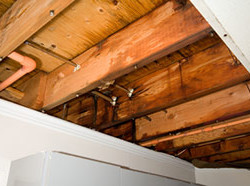Is All Black Colored Mold Dangerous?
With all the attention given to the problem of black mold in homes and buildings, people have come to assume that all such growths are toxic. In reality, there are types of dark-colored mold referred to as “cosmetic” that present little danger to your home or your health.
But if you discover black mold, how can you tell which type it is? Here is some helpful information about identifying and treating cosmetic mold.
What causes cosmetic mold?
Framing lumber used in building construction sometimes comes with a harmless form of black mold. These “bluestain” fungi develop mainly on sapwood, which is the main part of a tree used for building lumber.
Recognizing the signs
Indoor mold growth is usually uninterrupted, spreading out to neighboring surfaces. An interrupted patch of mold that appears to have stopped along a random straight line is the most common evidence of cosmetic mold. For instance, you may see mold that stops at the cut end of a rafter, or side-by-side beams where only one has growth.
Steps to take when discovering cosmetic mold
If black mold is found on dry wood in configurations as described above with no signs of active growth, no action is needed. However, the presence of cosmetic mold can support the growth of other, more troublesome varieties. Inspect and monitor areas of cosmetic mold for the appearance of active colonies or major risk factors such as dampness.
Why take a chance attempting to identify mold on your own? Get peace of mind with a free mold inspection by our experienced technicians at Stern Mold. Contact us today to schedule your appointment.

